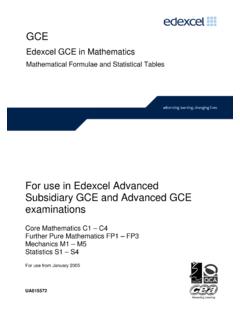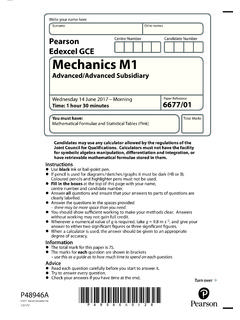Transcription of GCE in Chemistry Analysis of Chemicals AS CS - …
1 GCE Chemistry edexcel advanced subsidiary GCE in Chemistry (8CH01) edexcel advanced GCE in Chemistry (9CH01) Analysis of Chemicals for AS October 2007 Context study edexcel , a Pearson company, is the UK s largest awarding body offering academic and vocational qualifications and testing to more than 25,000 schools, colleges, employers and other places of learning here and in over 100 countries worldwide. Our qualifications include GCSE, AS and A Level, GNVQ, NVQ and the BTEC suite of vocational qualifications from entry level to BTEC Higher National Diplomas and Foundation Degrees. We deliver million exam scripts each year, with over million marked onscreen in 2006. As part of Pearson, edexcel has been able to invest in cutting-edge technology that has revolutionised the examinations system, this includes the ability to provide detailed performance data to teachers.
2 References to third party material made in this specification are made in good faith. edexcel does not endorse, approve or accept responsibility for the content of materials, which may be subject to change, or any opinions expressed therein. (Material may include textbooks, journals, magazines and other publications and websites.) Authorised by Roger Beard Prepared by Sarah Harrison All the material in this publication is copyright edexcel Limited 2007 Contents Introduction 1 Analysis of Chemicals 3 Unit 1 topic : Atomic structure and the periodic table 3 The age of the Earth 3 Determining the composition of the solar wind 4 The pharmaceutical industry 4 Drugs testing for athletes 5 Accurate relative atomic masses 5 Unit 2 topic : Mass spectra and IR 7 Analysis of organic molecules 7 References 9 Context study ( Analysis of Chemicals for AS) edexcel AS/A GCE in Chemistry (8CH01/9CH01) Issue 1 October 2007 edexcel Limited 2007 1 Introduction This document is designed to help teachers to understand the contemporary context of Analysis of Chemicals .
3 It should give teachers information on this context and on how to research it further if they wish. This document could also be given to students as introductory material. Context study ( Analysis of Chemicals for AS) edexcel AS/A GCE in Chemistry (8CH01/9CH01) Issue 1 October 2007 edexcel Limited 2007 2 Context study ( Analysis of Chemicals for AS) edexcel AS/A GCE in Chemistry (8CH01/9CH01) Issue 1 October 2007 edexcel Limited 2007 3 Analysis of Chemicals Mass spectrometry (MS) is an extremely valuable analytical tool used over a broad range of scientific disciplines. It is often used in conjunction with other techniques such as gas chromatography (GC), high performance liquid chromatography (HPLC). Unit 1 topic : Atomic structure and the periodic table The age of the Earth Geologists can date rocks or even obtain the age of the Earth. Here is an example using the rubidium/strontium dating method.
4 Natural rubidium consists of two isotopes, 85Rb and 87Rb. The latter is radioactive with a half-life of nearly fifty billion years. It emits a particle and turns into the non-radioactive isotope 87Sr. Natural strontium also contains 87Sr. Most minerals that contain rubidium also contain some strontium, so the age calculation must take into account the presence of the 87Sr at the beginning of the time interval. As molten rock material cools, first one mineral and then another solidifies. Rubidium is crystallised with potassium compounds fairly late in the solidification process together with some strontium compounds. Different rocks of the same age will have different Rb:Sr ratios although the initial 87Sr:86Sr ratio will be the same in all samples. If there is a non-radiogenic isotope of the daughter element present in the mineral, it can be used as a reference, and the ratios of the parent and daughter elements plotted as ratios with that reference isotope.
5 The slope of the curve then gives the time interval. (Non-radiogenic means that it is not produced by radioactive decay.) The rubidium/strontium dating method uses the non-radioactive isotope strontium-86 as a comparison standard. The relative amounts of 87Sr to 86Sr and 87Rb to 86Sr in different rock samples believed to be the same age are determined with great precision using a high-resolution mass spectrometer. A plot of these points, shown in figure 1, fits a straight line. The slope of this graph can be used to calculate the time since the solid rock formed from the molten material, ie the age of the Earth. The billion year age for the Earth is consistent with the results of the potassium/argon and uranium/lead estimations. Similar results are also obtained from the study of spontaneous fission events from uranium-238 and plutonium-244. Context study ( Analysis of Chemicals for AS) edexcel AS/A GCE in Chemistry (8CH01/9CH01) Issue 1 October 2007 edexcel Limited 2007 4 Figure 1 Plot of 87Sr v 87Rb standardised against 86Sr (Source: Kane 1987) For figure 1, the half-life, t1/2, for 87Rb = x 1010 years, so the age of the rock = x 109 years.
6 Determining the composition of the solar wind An exciting example of the use of mass spectrometers in astronomy is to determine the composition of the solar wind. The Solar and Heliospheric Observatory (SOHO) satellite has a group of instruments aboard known collectively as the Charge, Element and Isotope Analysis System (CELIAS). Up-to-date results indicate that hydrogen and helium make up per cent of the wind. The sensitive mass spectrometer has made measurements of the trace constituents, which include isotopes of silicon, sulphur, calcium, chromium, iron and nickel. Isotopes of neon and argon have been discovered in the wind, which were undetected in earlier satellite missions. The isotopes provide clues about where the solar wind originates in the dynamic structure of the sun. The pharmaceutical industry Mass spectrometry provides four essential requirements for the pharmaceutical industry, namely: sensitivity the accurate measurement of small samples selectivity can differentiate similar chemical environments even in stereoisomers speed fast turnaround times for Analysis high throughput dealing with large volumes of samples.
7 It is a valuable tool in each stage of drug development and has become the preferred analytical method for trace-mixture Analysis . It is used in conjunction with sample preparation, and chromatographic separation using GC or HPLC. Context study ( Analysis of Chemicals for AS) edexcel AS/A GCE in Chemistry (8CH01/9CH01) Issue 1 October 2007 edexcel Limited 2007 5 Modern methods of surface chemical characterization play an important role in the study and development of pharmaceutical products. Time-of-flight secondary ion mass spectrometry (ToF-SIMS) is one of the most important surface Analysis techniques. (Source: CSMA laboratories) The energy of an ion produced by electron bombardment is proportional to the square of its velocity, so the heavier the molecule the more slowly it passes through the spectrometer. In ToF-SIMS, short electrical pulses are applied to the material being studied.
8 The time taken for the ions released to travel to the detector is measured. This time depends on the m/z value of the molecular ion. No magnetic deflection or focusing is required with this method. The two interesting case studies below concern Analysis of contamination of pharmaceutical products. These typically arise post production and show the versatility of mass spectrometry. 1 Tablets from a commercial manufacturer were turning yellow (from white) on exposure to light. Mass spectrometry revealed that light was converting a CH2 COOH group to an aldehyde group leading to a new structure with a molecule of molar mass 30 less than the original. 2 A certain liquid drug showed signs of micro-crystallization, in the bulk. Careful extraction of a crystalline region onto filter paper followed by ToF-SIMS revealed that a polymer additive in the bottle stopper had leached out and reacted with the drug molecule.
9 Controlled release drug-delivery systems for heart or diabetic patients allow improved quality of life with fewer side effects and increased life expectancy. One approach is to encapsulate a drug bead within a multi-layer polymer coating where the properties of the latter control the rate of drug release. Since the production of this type of multi-component system is difficult, Analysis of the final product is vital. Mass spectrometry (ToF-SIMS) has proved ideally suited for this task and can provide an assessment of the thickness and uniformity of the coating layers as well as the distribution of the drug and other excipients (released substances) within the bead. Drugs testing for athletes Unfortunately a small minority of athletes who want to enhance their performance use drugs such as anabolic steroids sometimes during competitions. The same techniques that chemists use to analyse new products can of course be applied to drug testing.
10 Accurate relative atomic masses A traditional example of the uses of mass spectrometry is where chemists and physicists need to know accurate relative atomic masses (RAM). The relative abundances of the isotopes of an element may be obtained with a mass spectrometer. For example, the relative abundances of krypton isotopes is shown in figure 2. Context study ( Analysis of Chemicals for AS) edexcel AS/A GCE in Chemistry (8CH01/9CH01) Issue 1 October 2007 edexcel Limited 2007 6 Figure 2 Experimental mass spectrum of krypton (Source: Krane 1987) Krypton isotope mass relative abundance 78Kr 80Kr 82Kr 83Kr 84Kr 86Kr Table 1 Calculation to obtain the relative atomic mass (RAM) (Source: ) A weighted average of the isotopes in table 1 above gives a value of , the accepted atomic mass of krypton which appears in the periodic table.


